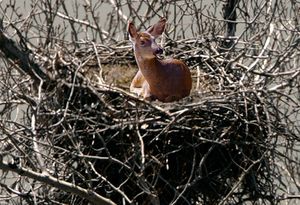UnNews:Biologists Study Nesting Habits of White-Tailed Deer
28 May 2012
PINCKNEY, Michigan -- White-Tailed Deer, Odocoileus viginianus, are a zoological mystery and a biological rarity, but recently, a select group of scientists has been able to shed some light on their nesting habits. Deer nest high in the tops of the tallest trees, making them very hard to study. Their nests are larger than those of any birds, so one would think that they would be easy to see, but deer are masters of camouflage, making their homes all but invisible to peering minds. Professor Nathaniel Korect is one of the scientists involved in the latest, and most in-depth, project to study the White-Tailed Deer. "Finding a deer nest is probably the most difficult part of the project." says Nat Korect. "Besides getting to the location, climbing the tree, avoiding the angry, swooping, protective deer, tagging the specimen, installing a monitor in the nest, and climbing down the tree again, still dodging flying hooves aimed at your face." Nat added. "It’s pretty hard!"
Deer mate for life, but if one mate disappears, the other will find a replacement. The male and female deer collaboratively start building the nest their first year together after performing one of the most elaborate courtship patterns in the Animal Kingdom. (The nest of a deer pair is used multiple times, and is expanded every year, sometimes reaching up to three tons in weight!) The display includes cartwheels, swooping, chasing, the locking of hooves, and free-falling.
Once the nest is built, the female deer lays a clutch of up to three eggs in the nest, incubating them alternately with the male. When the eggs hatch, it is unusual for all the fawns to survive into adulthood, the first hatching, or largest fawn usually requiring most of the food supply. Some fawns will even push siblings out of the nest in order to usurp their food.
When they are old enough, the fawns will descend to the forest floor to wander to a new place. Older deer, normally protective of their territory, will allow juvenile deer, still marked with white spots, to move through their area undisturbed, and on rare occasions, if the juvenile appears to be ailing, give them food.
At the age of one and a half years, the young deer will begin looking for a mate of their own, sometimes returning to the area near their birthplace to build a nest and rear offspring, thus restarting the cycle. "It’s an amazing process, it really is. I’m just grateful that I get to witness it," said Professor Korect. "The amazing life of an amazing animal."

